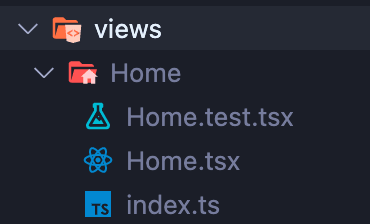This content originally appeared on DEV Community and was authored by Djamaile
(code is hosted at: https://github.com/djamaile/react-boilerplate-2021)
(last years post: https://dev.to/djamaile/how-i-structure-my-react-ts-applications-160g)
Last year, I created a post on how I structure my ReactJS projects. Now that it is summer vacation again, I shook the structure up a bit. But honestly there are few changes, because in the end React changed little (which is a good thing). So, in this post I will highlight what I changed/added.
Lets first start with a picture of the whole folder structure!
Now lets discuss the changes :)
? Api
In the API folder, I only now have a generic request function and what I added was react-query. If you are not familiar with react-query, it is a library for fetching server state. React-query comes with a lot of power like caching, data synchronisation, etc.
In this project, I have kept react-query pretty simple by only adding a defaultQueryFn, what looks like this:
import axios, { Method, AxiosResponse } from "axios";
const api = axios.create({
// baseURL: process.env.REACT_APP_HOST_BACKEND,
baseURL: "https://rickandmortyapi.com/api",
});
const request = <T>(
method: Method,
url: string,
params: any
): Promise<AxiosResponse<T>> => {
return api.request<T>({
method,
url,
params,
});
};
// Define a default query function that will receive the query key
export const defaultQueryFn = async ({ queryKey }: any): Promise<unknown> => {
const data = await request(queryKey[0], queryKey[1], queryKey[2]);
return data;
};
As you can see, the defaultQueryFn is calling the request function. Now we can add this to our QueryClient and in our Home view we can call the useQuery functionality like this:
import React from "react";
import "../../styles/home.css";
import { useQuery } from "react-query";
import { Header } from "../../components";
const Home: React.FC = () => {
const { data, error, isFetching } = useQuery(["GET", "/character", {}]);
if (isFetching) return <p>Is loading...</p>;
if (error) return <p>${error}</p>;
console.log(data);
return (
<div className="App">
<Header />
</div>
);
};
export default Home
I am still experimenting with react-query and see how I can use it better. But this is how I have been using it for now.
? Tests/Cypress
Yes, the infamous test folder. I actually ended up deleting it! I still have tests but I put them directly into the views/[view] folder.
I have to admit that I am not using Jest as much anymore. I have switched over to using Cypress. Cypress is a tool for end-to-end tests and I have been liking it so far. So, in cypress/integration/404_page.ts you can see I have a spec test that tests if the user can go back to the home page if the user has reached to 404 page.
describe('404 page', function() {
it('should give the option to return to home', function() {
cy.visit("/does-not-exists");
cy.contains('Return to Home');
cy.get('a')
.click()
cy.contains('Learn React', {timeout: 10000})
});
});
? Docker
I have added also Dockerfiles to my default repo. I have two separate two Dockerfiles, one for development and one for production.
FROM node:15-alpine AS builder
WORKDIR /app
COPY . .
RUN yarn install
RUN yarn build
FROM nginx:stable-alpine
WORKDIR /usr/share/nginx/html
RUN rm -rf *
COPY --from=builder /app/build .
ENTRYPOINT ["nginx", "-g", "daemon off;"
To build a image use:
$ docker build -t djam97/react-boilerplate-2021:prod -f docker/Dockerfile.prod .
☸️ Kubernetes
I use Kubernetes daily so that's why I added also some k8s manifests. They are pretty bare bone, but they get the job done and are easily extensible.
apiVersion: apps/v1
kind: Deployment
metadata:
name: react-boiler-plate
labels:
app: react-boiler-plate
spec:
replicas: 1
selector:
matchLabels:
app: react-boiler-plate
template:
metadata:
labels:
app: react-boiler-plate
spec:
containers:
- name: react-boiler-plate
image: djam97/react-boilerplate-2021:prod
imagePullPolicy: Never
ports:
- containerPort: 3000
---
apiVersion: v1
kind: Service
metadata:
name: react-boiler-plate-service
spec:
selector:
app: react-boiler-plate
ports:
- protocol: TCP
port: 3000
targetPort: 3000
To apply the manifests use:
$ kubectl apply -f k8s/
? Github workflow
I use Kubernetes daily, so that’s why I added also some k8s manifests. They are pretty bare bone, but they get the job done and are easily extensible.
name: Deploy site
on:
push:
branches: [main]
jobs:
build:
runs-on: ubuntu-latest
continue-on-error: true
strategy:
matrix:
node-version: [14.x]
steps:
- uses: actions/checkout@v2
- name: Setup Node
uses: actions/setup-node@v1
with:
node-version: "14.x"
- name: Get yarn cache
id: yarn-cache
run: echo "::set-output name=dir::$(yarn cache dir)"
- name: Cache dependencies
uses: actions/cache@v1
with:
path: ${{ steps.yarn-cache.outputs.dir }}
key: ${{ runner.os }}-yarn-${{ hashFiles('**/yarn.lock') }}
restore-keys: |
${{ runner.os }}-yarn-
- name: Yarn installation
run: yarn install && CI='' yarn build
- name: Deploy
uses: peaceiris/actions-gh-pages@v3
with:
github_token: ${{ secrets.ACCESS_TOKEN }}
publish_dir: ./buil
If you also want to use it, there are some steps you need to take. First, you need to create a personal access token in GitHub and add it as a secret to your repo as ACCESS_TOKEN. Last, change the homepage in package.json
- "homepage": "https://djamaile.github.io/react-boilerplate-2021",
+ "homepage": "https://<your username>.github.io/react-boilerplate-2021",
?️ Extra files
Besides the usual prettier, eslint, husky setup. I have also added @commitlint/config-conventional to make sure every commit complies with being a conventional commit. If you don't know what that is, you can read up on it here: https://www.conventionalcommits.org/en/v1.0.0/#summary
This content originally appeared on DEV Community and was authored by Djamaile
Djamaile | Sciencx (2021-08-06T01:19:42+00:00) How I structure my React /TS applications (2021). Retrieved from https://www.scien.cx/2021/08/06/how-i-structure-my-react-ts-applications-2021/
Please log in to upload a file.
There are no updates yet.
Click the Upload button above to add an update.


